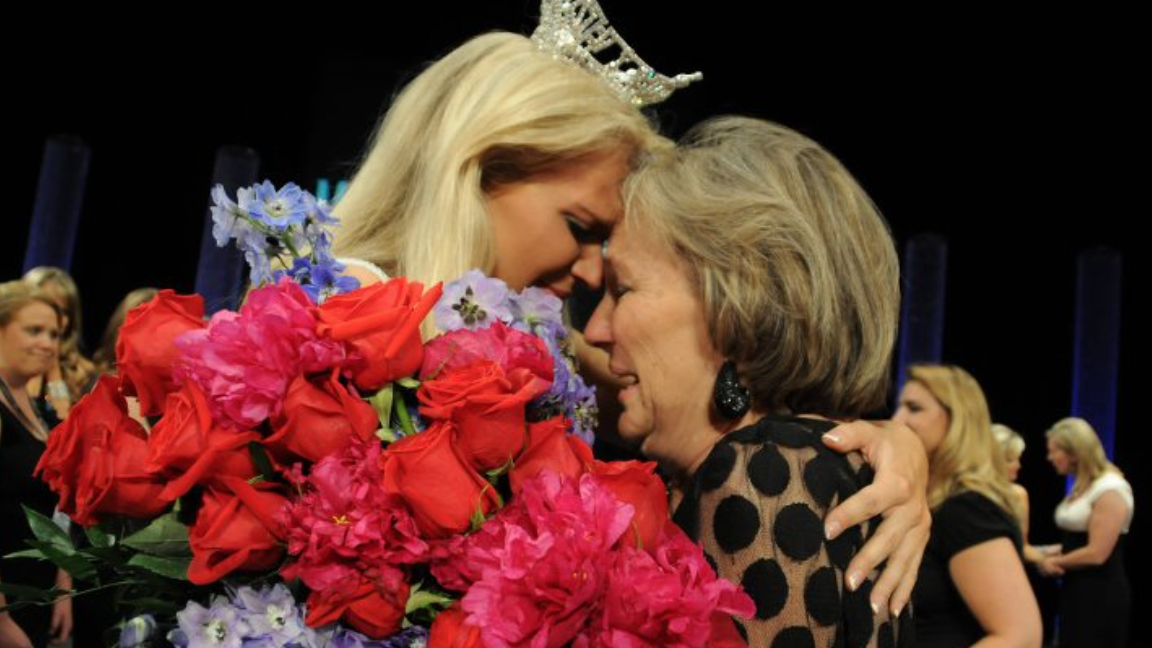The Miss America Daughters Club

[ad_1]
When Taylor Henry was five years old, she knew her mom had a sparkly crown. And when she went grocery shopping with her mother, she would overhear people say things like, “Oh, my gosh, it’s Heather!” Taylor concluded that she must be the daughter of a Disney princess. When she asked if that was true, Taylor’s mother—Heather French Henry, Miss America 2000—replied, “Close, but no.”
Taylor, now 17, laughs at her younger self. She still loves Disney and her mom, but she has a different understanding of what that crown means. “My mom was Miss America,” she says. “But what matters is that she’s a hard-working individual who works with our nation’s veterans.”
I can relate to Taylor, as I’m also the daughter of a Miss America. My mom is Pam Eldred, Miss America 1970, who represented my home state of Michigan when she won the title. I never likened my mom to a Disney princess, but I definitely knew her crowns were important—they occupied an entire row of a bookshelf in my childhood home—and that the grocery store was a fraught space. Mom was careful never to go shopping “without her face on” because so many people would recognize her.
Despite the public’s perception of pageants, winning the Miss America crown remains a unique achievement. Since the first winner was named in 1921, only 93 women have had the title. But the Miss America daughters club is even more exclusive, as just over half of the winners have had daughters.
I’ve often wondered if my experience growing up as the daughter of a Miss America was unique, so I reached out to two dozen other daughters of past winners. Some of them are tweens, while others are in their late 60s. We’re spread out geographically, and we’ve chosen a variety of career paths, from athlete and attorney to Broadway performer, journalist, teacher, and mom ourselves.
The meaning of being a member of the Miss America daughters club has changed over the decades as the cultural power of the pageant itself has waned. But it wasn’t always that way. Carol Koplan’s mother, Rosemary LaPlanche, was Miss America 1941.
The earliest Miss America daughter with whom I spoke, Carol grew up in California where her mother had a movie studio contract and her father produced and directed television shows (her mom was Miss Studio City before becoming Miss California).
According to Carol, “Well, [being Miss America] was different then because there was only one major pageant—they didn’t have Miss Universe at that time, and all the other pageants…. [Mom] was a celebrity, on the war bond tour, and in all the soldiers’ lockers.”
Carol Koplan with her parents, Rosemary LaPlanche (Miss America 1941) and Harry Koplan, around 1955 when she was four years old. Today, Carol is an artist and a retired teacher; she was named Los Angeles Teacher of the Year in 2004. (Courtesy of Carol Koplan)
Carol’s experience contrasts with that of Lynlee Bell, who at 11 years old is the youngest Miss America daughter with whom I spoke. Her mom is Debbye Turner Bell, 1990’s winner, and only the second Black woman to win the title. When Lynlee’s friends at school found out her mom had been Miss America, they asked, “What’s that?” “Nobody really had any interest or knew what [Miss America] was,” she says
While public interest in Miss America has declined over time, the sense of camaraderie within generations of its daughters remains strong. Stacy Sempier is the daughter of Evelyn Ay Sempier, Miss America 1954. She believes that there’s “an immediate connection between Miss America daughters because we have had people ask us the same questions, about the year our moms won, if we still have the crown, what her talent was. I think that’s a lovely legacy of shared experience on our part as daughters.”
Stacy’s godmother is Lee Meriwether, Miss America 1955, and she grew up thinking of Meriwether’s daughter, Lesley Aletter, as her godsister.
Ava Johnson, 15, whose mom is Nicole Johnson (Miss America 1999), and Victoria Ebner, 12, whose mom is Katie Harman Ebner (Miss America 2002), have forged a friendship despite living on different coasts of the country. In 2016 they met up at Disneyland when Nicole Johnson was speaking in California at a PADRE Foundation event. (PADRE stands for Pediatrics-Adolescent Diabetes Research Education; when she was Miss America, Johnson’s platform issue was diabetes awareness, as she lives with type 1 diabetes and competed while wearing an insulin pump.) Ava and Victoria have maintained their relationship via text.
The first fellow member of the Miss America daughters club I ever met was Vandy Scoates. Vandy’s mom is Miss America 1965, Vonda Kay Van Dyke. Vandy and I connected when our moms took us to the 70th anniversary of the Miss America Pageant. We were both only children of former winners, and I remember feeling an immediate kinship with Vandy. We were just a year apart in age so it was easy to hang out as our moms signed autographs and took pictures with fans.
[ad_2]
Source link




